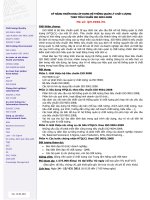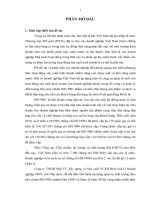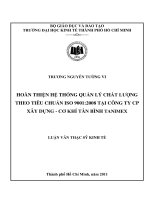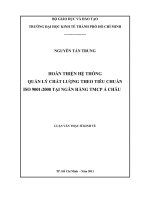Tiêu chuẩn iso 06721 4 2008
Bạn đang xem bản rút gọn của tài liệu. Xem và tải ngay bản đầy đủ của tài liệu tại đây (196.66 KB, 16 trang )
INTERNATIONAL
STANDARD
ISO
6721-4
Externe elektronische Auslegestelle-Beuth-SNV shop Schweizer.Normen-Vereinigung ein Joint Venture mit TFV-KdNr.6950278-ID.BE17F0F0131D4781DBCB7C2650AF0FD3.1-2009-06-11 12:16:54
Second edition
2008-05-01
Plastics — Determination of dynamic
mechanical properties —
Part 4:
Tensile vibration — Non-resonance
method
Plastiques — Détermination des propriétés mécaniques dynamiques —
Partie 4: Vibration en traction — Méthode hors résonance
Reference number
ISO 6721-4:2008(E)
© ISO 2008
ISO 6721-4:2008(E)
PDF disclaimer
This PDF file may contain embedded typefaces. In accordance with Adobe's licensing policy, this file may be printed or viewed but
shall not be edited unless the typefaces which are embedded are licensed to and installed on the computer performing the editing. In
downloading this file, parties accept therein the responsibility of not infringing Adobe's licensing policy. The ISO Central Secretariat
accepts no liability in this area.
Externe elektronische Auslegestelle-Beuth-SNV shop Schweizer.Normen-Vereinigung ein Joint Venture mit TFV-KdNr.6950278-ID.BE17F0F0131D4781DBCB7C2650AF0FD3.1-2009-06-11 12:16:54
Adobe is a trademark of Adobe Systems Incorporated.
Details of the software products used to create this PDF file can be found in the General Info relative to the file; the PDF-creation
parameters were optimized for printing. Every care has been taken to ensure that the file is suitable for use by ISO member bodies. In
the unlikely event that a problem relating to it is found, please inform the Central Secretariat at the address given below.
COPYRIGHT PROTECTED DOCUMENT
© ISO 2008
All rights reserved. Unless otherwise specified, no part of this publication may be reproduced or utilized in any form or by any means,
electronic or mechanical, including photocopying and microfilm, without permission in writing from either ISO at the address below or
ISO's member body in the country of the requester.
ISO copyright office
Case postale 56 • CH-1211 Geneva 20
Tel. + 41 22 749 01 11
Fax + 41 22 749 09 47
Web www.iso.org
Published in Switzerland
ii
© ISO 2008 – All rights reserved
ISO 6721-4:2008(E)
Contents
Page
Externe elektronische Auslegestelle-Beuth-SNV shop Schweizer.Normen-Vereinigung ein Joint Venture mit TFV-KdNr.6950278-ID.BE17F0F0131D4781DBCB7C2650AF0FD3.1-2009-06-11 12:16:54
Foreword............................................................................................................................................................ iv
1
Scope ..................................................................................................................................................... 1
2
Normative references ........................................................................................................................... 1
3
Terms and definitions........................................................................................................................... 1
4
Principle ................................................................................................................................................. 1
5
Test device ............................................................................................................................................ 2
6
Test specimens ..................................................................................................................................... 3
7
Number of specimens .......................................................................................................................... 4
8
Conditioning.......................................................................................................................................... 4
9
Procedure .............................................................................................................................................. 4
10
Expression of results ........................................................................................................................... 5
11
Precision ................................................................................................................................................ 8
12
Test report ............................................................................................................................................. 8
© ISO 2008 – All rights reserved
iii
ISO 6721-4:2008(E)
Externe elektronische Auslegestelle-Beuth-SNV shop Schweizer.Normen-Vereinigung ein Joint Venture mit TFV-KdNr.6950278-ID.BE17F0F0131D4781DBCB7C2650AF0FD3.1-2009-06-11 12:16:54
Foreword
ISO (the International Organization for Standardization) is a worldwide federation of national standards bodies
(ISO member bodies). The work of preparing International Standards is normally carried out through ISO
technical committees. Each member body interested in a subject for which a technical committee has been
established has the right to be represented on that committee. International organizations, governmental and
non-governmental, in liaison with ISO, also take part in the work. ISO collaborates closely with the
International Electrotechnical Commission (IEC) on all matters of electrotechnical standardization.
International Standards are drafted in accordance with the rules given in the ISO/IEC Directives, Part 2.
The main task of technical committees is to prepare International Standards. Draft International Standards
adopted by the technical committees are circulated to the member bodies for voting. Publication as an
International Standard requires approval by at least 75 % of the member bodies casting a vote.
Attention is drawn to the possibility that some of the elements of this document may be the subject of patent
rights. ISO shall not be held responsible for identifying any or all such patent rights.
ISO 6721-4 was prepared by Technical Committee ISO/TC 61, Plastics, Subcommittee SC 2, Mechanical
properties.
This second edition cancels and replaces the first edition (ISO 6721-4:1994), of which it constitutes a minor
revision. The main change is the updating of the normative references.
ISO 6721 consists of the following parts, under the general title Plastics — Determination of dynamic
mechanical properties:
⎯
Part 1: General principles
⎯
Part 2: Torsion-pendulum method
⎯
Part 3: Flexural vibration — Resonance-curve method
⎯
Part 4: Tensile vibration — Non-resonance method
⎯
Part 5: Flexural vibration — Non-resonance method
⎯
Part 6: Shear vibration — Non-resonance method
⎯
Part 7: Torsional vibration — Non-resonance method
⎯
Part 8: Longitudinal and shear vibration — Wave-propagation method
⎯
Part 9: Tensile vibration — Sonic-pulse propagation method
⎯
Part 10: Complex shear viscosity using a parallel-plate oscillatory rheometer
iv
© ISO 2008 – All rights reserved
INTERNATIONAL STANDARD
ISO 6721-4:2008(E)
Externe elektronische Auslegestelle-Beuth-SNV shop Schweizer.Normen-Vereinigung ein Joint Venture mit TFV-KdNr.6950278-ID.BE17F0F0131D4781DBCB7C2650AF0FD3.1-2009-06-11 12:16:54
Plastics — Determination of dynamic mechanical properties —
Part 4:
Tensile vibration — Non-resonance method
1
Scope
This part of ISO 6721 describes a forced, non-resonance method for determining the components of the
tensile complex modulus E* of polymers at frequencies typically in the range 0,01 Hz to 100 Hz. The method
is suitable for measuring dynamic storage moduli in the range 0,01 GPa to 5 GPa. Although materials with
moduli outside this range may be studied, alternative modes of deformation should yield higher accuracy [i.e.
a shear mode for E′ < 0,01 GPa (see ISO 6721-6) and a flexural mode for E′ > 5 GPa (see ISO 6721-3 or
ISO 6721-5)].
This method is particularly suited to the measurement of loss factors greater than 0,1 and may therefore be
conveniently used to study the variation of dynamic properties with temperature and frequency through most
of the glass-rubber relaxation region (see ISO 6721-1:2001, Subclause 9.4). The availability of data
determined over wide ranges of both frequency and temperature enables master plots to be derived, using
frequency-temperature shift procedures, which display dynamic properties over an extended frequency range
at different temperatures.
2
Normative references
The following referenced documents are indispensable for the application of this document. For dated
references, only the edition cited applies. For undated references, the latest edition of the referenced
document (including any amendments) applies.
ISO 6721-1:2001, Plastics — Determination of dynamic mechanical properties — Part 1: General principles
ISO 6721-3, Plastics — Determination of dynamic mechanical properties — Part 3: Flexural vibration —
Resonance-curve method
ISO 6721-5, Plastics — Determination of dynamic mechanical properties — Part 5: Flexural vibration — Nonresonance method
ISO 6721-6, Plastics — Determination of dynamic mechanical properties — Part 6: Shear vibration — Nonresonance method
3
Terms and definitions
For the purposes of this document, the terms and definitions given in ISO 6721-1:2001, Clause 3, apply.
4
Principle
The specimen is subjected to a sinusoidal tensile force or deformation at a frequency significantly below the
fundamental resonance frequency for the clamped/free longitudinal mode (see 10.2.2). The amplitudes of the
© ISO 2008 – All rights reserved
1
ISO 6721-4:2008(E)
force and displacement cycles applied to the specimen and the phase angle between these cycles are
measured. The storage and loss factor are calculated using equations given in Clause 10.
5
Test device
Externe elektronische Auslegestelle-Beuth-SNV shop Schweizer.Normen-Vereinigung ein Joint Venture mit TFV-KdNr.6950278-ID.BE17F0F0131D4781DBCB7C2650AF0FD3.1-2009-06-11 12:16:54
5.1
5.1.1
Loading assembly
General
The requirements on the apparatus are that it shall permit measurements of the amplitudes of, and the phase
angle between, the force and displacement cycles for a specimen subjected to a sinusoidal tensile force or
deformation. Various designs of apparatus are possible: a suitable version is shown schematically in Figure 1.
A sinusoidal force is generated by the vibrator V and applied to one end of the specimen S by means of the
clamp C1. The amplitude and frequency of the vibrator table displacement are variable and monitored by the
transducer D. The member between V and C1 shall be much stiffer than the specimen and shall have a low
thermal conductance if the specimen is to be enclosed in a temperature-controlled cabinet.
NOTE
Whilst each member of the load assembly may have a much higher stiffness than the specimen, the presence
of clamped or bolted connections can significantly increase the apparatus compliance. It may then be necessary to apply a
compliance correction as described in 10.2.4.
At the other end of the specimen, a second clamp C2 is connected to a force transducer F which is supported
by a rigid frame. The member between C2 and F shall also have sufficient stiffness and low thermal
conductance.
5.1.2
Clamps
The clamps shall be capable of gripping the test specimen with sufficient force to prevent the specimen from
slipping during the tensile deformation and maintaining the force at low temperatures. Any misalignment of the
clamps with respect to the force transducer will produce a lateral component of the force applied to the
transducer during loading of the specimen. The alignment of the loading assembly and test specimen shall be
such that any lateral component recorded by the transducer is less than 1 % of the applied tensile force. A
clamp design with self-aligning faces is recommended since this will maintain alignment of the specimen axis
with the axis of the load assembly independently of specimen thickness.
The derivation of a length correction (see 10.2.5) requires measurements of specimen stiffness for different
values of the specimen length as defined by the clamp separation. These may be made on a single specimen
if one of the clamps has a hole in the centre of its base through which the specimen may pass as the clamp
separation is reduced.
5.1.3
Transducers
The term transducer in this part of ISO 6721 refers to any device capable of measuring the applied force or
displacement, or the ratio of these quantities, as a function of time. The calibrations of the transducers shall be
traceable to national standards for the measurement of force and length. The calibrations shall be accurate to
± 2 % of the minimum force and displacement cycle amplitudes applied to the specimen for the purpose of
determining dynamic properties.
5.2
Electronic data-processing equipment
Data-processing equipment shall be capable of recording the force and displacement cycle amplitudes to an
accuracy of ± 1 %, the phase angle between the force and displacement cycles to an accuracy of ± 0,1° and
the frequency to an accuracy of ± 10 %.
2
© ISO 2008 – All rights reserved
ISO 6721-4:2008(E)
5.3
Temperature measurement and control
See ISO 6721-1:2001, Subclauses 5.3 and 5.5.
5.4
Devices for measuring test specimen dimensions
Externe elektronische Auslegestelle-Beuth-SNV shop Schweizer.Normen-Vereinigung ein Joint Venture mit TFV-KdNr.6950278-ID.BE17F0F0131D4781DBCB7C2650AF0FD3.1-2009-06-11 12:16:54
See ISO 6721-1:2001, Subclause 5.6.
Key
F
C1, C2
S
D
V
force transducer
clamps
test specimen
displacement transducer
vibrator
Figure 1 — Schematic diagram of a suitable loading assembly for determining dynamic moduli
by a tensile forced non-resonance method
6
6.1
Test specimens
General
See ISO 6721-1:2001, Clause 6.
© ISO 2008 – All rights reserved
3
ISO 6721-4:2008(E)
Externe elektronische Auslegestelle-Beuth-SNV shop Schweizer.Normen-Vereinigung ein Joint Venture mit TFV-KdNr.6950278-ID.BE17F0F0131D4781DBCB7C2650AF0FD3.1-2009-06-11 12:16:54
6.2
Shape and dimensions
Test specimens of rectangular cross-section are recommended to facilitate load introduction. The width and
thickness shall not vary along the specimen length by more than 3 % of the mean value. Where high accuracy
in results is required, a specimen length is recommended which will permit a clamp separation of about
100 mm or more in order to achieve adequate accuracy in the determination of the dynamic tensile strain. It is
also recommended that the length of the specimen between the clamps be greater than six times the
specimen width in order to make the constraint by the clamps to free lateral contraction of the specimen
negligible.
Cross-sectional dimensions are not critical. For test conditions under which the polymer exhibits glassy
behaviour, the cross-sectional area shall be selected sufficiently small so that the vibrator is able to generate
tensile displacements that may be measured with adequate accuracy. Alternatively, when the polymer exhibits
rubbery behaviour, a larger cross-sectional area may be necessary to achieve sufficient accuracy in the
measurement of force.
NOTE
A variation in dynamic properties may be observed between specimens of different thickness prepared by
injection moulding owing to differences which may be present in the structure of the polymer in each specimen.
6.3
Preparation
See ISO 6721-1:2001, Subclause 6.3.
7
Number of specimens
See ISO 6721-1:2001, Clause 7.
8
Conditioning
See ISO 6721-1:2001, Clause 8.
9
9.1
Procedure
Test atmosphere
See ISO 6721-1:2001, Subclause 9.1.
9.2
Measurement of specimen cross-section
See ISO 6721-1:2001, Subclause 9.2.
9.3
Clamping the specimen
Mount the specimen between the clamps using a clamping force that is sufficient to prevent slip under all test
conditions. If measurements are observed to depend upon clamp pressure, then a constant pressure should
preferably be used for all measurements, especially when applying a length correction (see 10.2.5).
NOTE
If measurements are observed to depend upon clamp pressure then the clamped area of the specimen is
probably too small. A larger clamp face or a wider specimen should eliminate this problem.
9.4
Varying the temperature
See ISO 6721-1:2001, Subclause 9.4.
4
© ISO 2008 – All rights reserved
ISO 6721-4:2008(E)
9.5
Performing the test
Externe elektronische Auslegestelle-Beuth-SNV shop Schweizer.Normen-Vereinigung ein Joint Venture mit TFV-KdNr.6950278-ID.BE17F0F0131D4781DBCB7C2650AF0FD3.1-2009-06-11 12:16:54
A static tensile force shall be applied to the specimen that is sufficient to prevent buckling under the
decreasing part of the superimposed dynamic load. A dynamic force shall then be applied which yields force
and displacement signal amplitudes which can be measured by the transducers to the accuracy specified in
5.1.3.
NOTE
If the tensile strain exceeds the limit for linear behaviour, then the derived dynamic properties will depend on
the magnitude of the applied strain. This limit varies with the composition of the polymer and the temperature and is
typically in the region of 0,2 % for glassy plastics.
The amplitudes of, the phase difference between and the frequency of the force and displacement signals and
the temperature of the test shall be recorded. Where measurements are to be made over ranges of frequency
and temperature, it is recommended that the lowest temperature be selected first and measurements be made
with increasing frequency, keeping the temperature constant. The frequency range is then repeated at the
next higher temperature (see ISO 6721-1:2001, Subclause 9.4).
For those test conditions under which the polymer exhibits medium or high loss (for example in the glassrubber transition region), the energy dissipated by the polymer may raise its temperature sufficiently to give a
significant change in dynamic properties. Any temperature rise will increase rapidly with increasing strain
amplitude and frequency. If the data-processing electronics is capable of analysing the transducer outputs
within the first few cycles, then the influence of any temperature rise will then change with time as the
specimen temperature continues to rise, and such observations will indicate the need to exercise some
caution in the presentation and interpretation of results.
10 Expression of results
10.1 Symbols
La
length of the specimen between clamps, in metres
l
length correction term, in metres
b
specimen width, in metres
d
specimen thickness, in metres
f
measurement frequency, in hertz
sA
measured amplitude of the dynamic displacement, in metres
∆FA
measured amplitude of the dynamic force, in newtons
δEa, δE
measured phase difference and corrected phase difference, respectively, between the force
and displacement cycles, in degrees
ka, k
measured magnitude and corrected magnitude, respectively, of the complex stiffness of the
specimen, in newtons per metre
E′a, E′
apparent tensile storage modulus and corrected tensile storage modulus, respectively, in
pascals
E″
tensile loss modulus, in pascals
tanδEa, tanδE
apparent tensile loss factor and corrected tensile loss factor, respectively
kF
stiffness of the force transducer, in newtons per metre
© ISO 2008 – All rights reserved
5
Externe elektronische Auslegestelle-Beuth-SNV shop Schweizer.Normen-Vereinigung ein Joint Venture mit TFV-KdNr.6950278-ID.BE17F0F0131D4781DBCB7C2650AF0FD3.1-2009-06-11 12:16:54
ISO 6721-4:2008(E)
mF
mass of that part of the loading assembly between the force transducer and the test specimen,
in kilograms
k∞
measured stiffness, in newtons per metre, of a steel test specimen whose cross-sectional
dimensions are the maximum that the clamps can accommodate (see Note). This specimen
shall be at least 100 times stiffer than the stiffest polymer specimen to be tested
NOTE
The magnitude of k∞ will give an estimate of the stiffness of the loading assembly, which is equivalent to a
spring connected in series with the specimen, and will enable a correction for apparatus compliance to be deduced (see
10.2.4).
10.2 Calculation of the tensile storage modulus E′
10.2.1 General
An approximate value for the tensile storage modulus E′a is determined from the equation
E a′ =
k L
∆FA L a
×
cos δ Ea = a a cos δ Ea
sA
bd
bd
(1)
10.2.2 Avoidance of specimen resonance
Equation (1) becomes invalid as the drive frequency approaches the fundamental longitudinal resonance
frequency fs of the specimen, given approximately by
fs =
1 ⎛ E a′ ⎞
⎜
⎟
2 La ⎝ ρ ⎠
12
(2)
where ρ is the polymer density in kilograms per cubic metre. An error in the use of Equation (1) becomes
significant at applied frequencies such that
f W
0,02 ⎛ E a′ ⎞
⎜
⎟
La ⎝ ρ ⎠
12
(3)
Calculations of dynamic properties shall therefore be confined to frequencies below that given by the equality
in Equation (3).
10.2.3 Correction for transducer resonance
At sufficiently high frequencies, the applied deformation will excite the force transducer into resonance. The
resonance frequency fF is given by
fF =
1
2π
⎛ kF ⎞
⎜
⎟
⎝ mF ⎠
12
(4)
The transducer output will have a significant error for all applied frequencies such that
f > 0,1 f F
(5)
The resonance frequency fF of the force transducer and supported mass mF can be determined directly by
recording the natural frequency of the transducer output after striking the attached clamp without the
specimen.
The specimen stiffness corrected for transducer resonance is given to a good approximation by the equation
6
© ISO 2008 – All rights reserved
ISO 6721-4:2008(E)
⎛
4π 2mF f 2 ⎞
k = k a ⎜1 −
⎟ = ka
⎜
⎟
kF
⎝
⎠
⎛
f2 ⎞
⎜1 − 2 ⎟
⎜
f F ⎟⎠
⎝
(6)
Externe elektronische Auslegestelle-Beuth-SNV shop Schweizer.Normen-Vereinigung ein Joint Venture mit TFV-KdNr.6950278-ID.BE17F0F0131D4781DBCB7C2650AF0FD3.1-2009-06-11 12:16:54
It is recommended that Equations (4) and (5) be used to select a force transducer whose resonance
frequency is above the frequency range for which a correction to the force measurement is necessary.
10.2.4 Correction for apparatus compliance
If ka is greater than 0,02k∞, then the compliance of the test assembly is not negligible and the measured
displacement differs significantly from that of the specimen. The following correction shall then be applied:
k cos δ E =
k a ( cos δ Ea − k a k ∞ )
1 − 2 ( k a k ∞ ) cos δ Ea
(7)
where δE is given by Equation (10). The value of kcosδE obtained from Equation (7) shall be used in place of
kacosδEa in Equation (1) to give a more accurate estimate for E′a.
NOTE
The compliance correction is unnecessary if the displacement transducer is located so as to measure the
change in clamp separation or if extensometers are attached to the specimen.
10.2.5 Application of a length correction
Using the measured clamp separation La for the specimen length in Equation (1) takes no account of some
distortion of the specimen within and around the clamp. Applying a small correction to La such that the
effective length is La + l and assuming l is independent of La yields from Equation (1)
E′ =
k ( La + l )
bd
cos δ Ea
(8)
where a correction for apparatus compliance has been applied where necessary using Equation (7). A value
for the length correction l may be determined from measurements of specimen stiffness k for a series of
different clamp separations La. From Equation (8), a plot of 1/(kcosδEa) against La enables l to be determined
from the intercept at 1/(kcosδEa) = 0 and E′ from the gradient.
NOTE 1
The value for l will vary with the cross-sectional dimensions of the specimen and with temperature if this
causes significant changes in dynamic modulus.
NOTE 2
The derivation of a length correction is unnecessary if the dynamic strain is measured using extensometers
attached to the specimen.
10.3 Calculation of the tensile loss factor tanδE
An approximate value for the tensile loss factor is tanδEa.
If ka is greater than 0,02k∞, then the compliance of the loading assembly will influence the accuracy of the
phase angle measurement. The loss factor shall then be obtained using
tan δ E =
tan δ Ea
⎛
⎞
ka
1− ⎜
⎟
k
cos
δ
Ea ⎠
⎝ ∞
(9)
NOTE
If the origin of the source of compliance in the loading assembly arises through clamped or bolted connections,
there may be a contribution from friction to the measured phase angle δEa. The magnitude of the resulting error increases
with the ratio ka/k∞. This source of error can be avoided by locating the displacement transducer so that the change in the
clamp separation is measured or by attaching extensometers to the specimen.
© ISO 2008 – All rights reserved
7
ISO 6721-4:2008(E)
10.4 Calculation of the tensile loss modulus
The loss modulus E″ shall be calculated from
E ′′ = E ′ tan δ E
(10)
Externe elektronische Auslegestelle-Beuth-SNV shop Schweizer.Normen-Vereinigung ein Joint Venture mit TFV-KdNr.6950278-ID.BE17F0F0131D4781DBCB7C2650AF0FD3.1-2009-06-11 12:16:54
10.5 Varying the temperature
See ISO 6721-1:2001, Subclause 9.4.
11 Precision
The precision of this test method is not known because interlaboratory data are not available. When
interlaboratory data are obtained, a precision statement will be added at the following revision.
12 Test report
The test report shall include the following information:
a)
a reference to this part of ISO 6721;
b)
to m) see ISO 6721-1:2001, Clause 12;
n)
the dynamic strain amplitude given approximately by sA/La.
8
© ISO 2008 – All rights reserved
Externe elektronische Auslegestelle-Beuth-SNV shop Schweizer.Normen-Vereinigung ein Joint Venture mit TFV-KdNr.6950278-ID.BE17F0F0131D4781DBCB7C2650AF0FD3.1-2009-06-11 12:16:54
This page is intentionally blank.
Externe elektronische Auslegestelle-Beuth-SNV shop Schweizer.Normen-Vereinigung ein Joint Venture mit TFV-KdNr.6950278-ID.BE17F0F0131D4781DBCB7C2650AF0FD3.1-2009-06-11 12:16:54
This page is intentionally blank.
Externe elektronische Auslegestelle-Beuth-SNV shop Schweizer.Normen-Vereinigung ein Joint Venture mit TFV-KdNr.6950278-ID.BE17F0F0131D4781DBCB7C2650AF0FD3.1-2009-06-11 12:16:54
This page is intentionally blank.
Externe elektronische Auslegestelle-Beuth-SNV shop Schweizer.Normen-Vereinigung ein Joint Venture mit TFV-KdNr.6950278-ID.BE17F0F0131D4781DBCB7C2650AF0FD3.1-2009-06-11 12:16:54
ISO 6721-4:2008(E)
Price based on 8 pages
ICS 83.080.01
© ISO 2008 – All rights reserved









